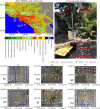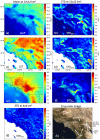Resolving and Predicting Neighborhood Vulnerability to Urban Heat and Air Pollution: Insights From a Pilot Project of Community Science
- PMID: 35509494
- PMCID: PMC9055464
- DOI: 10.1029/2021GH000575
Resolving and Predicting Neighborhood Vulnerability to Urban Heat and Air Pollution: Insights From a Pilot Project of Community Science
Abstract
Urban heat and air pollution, two environmental threats to urban residents, are studied via a community science project in Los Angeles, CA, USA. The data collected, for the first time, by community members, reveal the significance of both the large spatiotemporal variations of and the covariations between 2 m air temperature (2mT) and ozone (O3) concentration within the (4 km) neighborhood scale. This neighborhood variation was not exhibited in either daily satellite observations or operational model predictions, which makes the assessment of community health risks a challenge. Overall, the 2mT is much better predicted than O3 by the weather and research forecast model with atmospheric chemistry (WRF-Chem). For O3, diurnal variation is better predicted by WRF-Chem than spatial variation (i.e., underestimated by 50%). However, both WRF-chem and the surface observation show the overall consistency in describing statistically significant covariations between O3 and 2mT. In contrast, satellite-based land surface temperature at 1 km resolution is insufficient to capture air temperature variations at the neighborhood scale. Community engagement is augmented with interactive maps and apps that show the predictions in near real time and reveals the potential of green canopy to reduce air temperature and ozone; but different tree types and sizes may lead to different impacts on air temperature, which is not resolved by the WRF-Chem. These findings highlight the need for community science engagement to reveal otherwise impossible insights for models, observations, and real-time dissemination to understand, predict, and ultimately mitigate, urban neighborhood vulnerability to heat and air pollution.
Keywords: air quality prediction; community science and engagement; environment and public health; neighborhood scale variation; temperature and ozone; urban heat and air pollution.
© 2022 The Authors. GeoHealth published by Wiley Periodicals LLC on behalf of American Geophysical Union.
Conflict of interest statement
The authors declare no conflicts of interest relevant to this study.
Figures








References
-
- Chambers, L. H. , McKeown, M. A. , McCrea, S. A. , Martin, A. M. , Rogerson, T. M. , & Bedka, K. M. (2017). CERES S’COOL project update: The evolution and value of a long‐running education project with a foundation in NASA Earth science missions. Bulletin of the American Meteorological Society, 98(3), 473–483. 10.1175/bams-d-15-00248.1 - DOI - PMC - PubMed
-
- Churkina, G. , Grote, R. , Butler, T. M. , & Lawrence, M. (2015). Natural selection? Picking the right trees for urban greening. Environmental Science & Policy, 47, 12–17. 10.1016/j.envsci.2014.10.014 - DOI
-
- Elmore, K. L. , Flamig, Z. L. , Lakshmanan, V. , Kaney, B. T. , Farmer, V. , Reeves, H. D. , & Rothfusz, L. P. (2014). MPING: Crowd‐sourcing weather reports for research. Bulletin of the American Meteorological Society, 95(9), 1335–1342. 10.1175/bams-d-13-00014.1 - DOI
-
- Escobedo, F. J. , & Nowak, D. J. (2009). Spatial heterogeneity and air pollution removal by an urban forest. Landscape and Urban Planning, 90(3), 102–110. 10.1016/j.landurbplan.2008.10.021 - DOI
LinkOut - more resources
Full Text Sources
